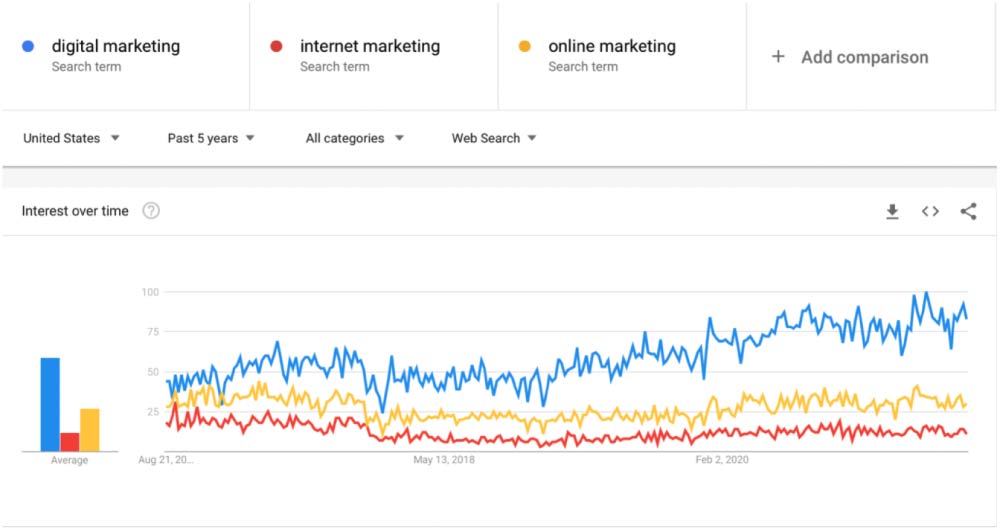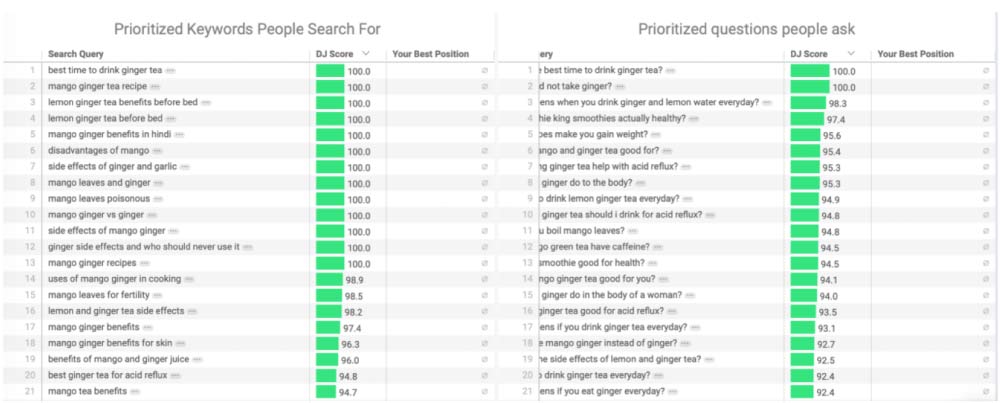A Comprehensive Guide to SEO Keyword Research
Let’s start off simply, by answering the question: what is SEO? SEO is short for “Search Engine Optimization.” This refers to the practice of trying to optimize your website or webpage to pop up first when people search for terms that are relevant to these pieces of content.
The way that it works is that the search engine goes out and examines all the content it can find online using crawlers—bots that browse the internet to index information for the search engine. In order to determine what shows up first in the search results, the search engine assigns values to the info the crawlers return based on variables like how relevant the information is to the search term and how readable the page is.
The optimization part of SEO comes into play when people try to figure out what those search engines prioritize and include that in their content in order to appear at the top of the list—after all, the number one result in Google gets 31.7% of all clicks.
This optimization can take different forms, from linking to other content to having a well-organized and easy-to-read page. In fact, Google uses 200 factors to determine how to rank each webpage that it comes across. Many of those factors include keywords utilization.
Keywords signal to crawlers what your content is about and why they should list your content high in the rankings. We’re going to take a look at keywords and take a deep dive into keyword research for SEO, as well as explore different tools you can use to find those keywords.
What Is Keyword Research In SEO?
SEO keyword research is the process of identifying what words and phrases people type in when they are trying to find information about a specific topic online. Keyword research is about exploring and understanding how people use language on the internet.
Keyword research can give you an understanding of the demand for certain keywords and of what it takes to compete for the top position. Keep in mind that there are different types of keywords to research. Here are the top ten types of keywords you may encounter in your research:
1. Short-Tail Keywords
A short-tail keyword is a phrase of two to three words. Sometimes called a “head keyword,” these terms are typically high volume and can be tricky to win due to the broadness of the term.
For example, take the phrase “mango ginger.” This could refer to a type of beverage or a dried fruit mix or even a paint color! Without context, these short keywords may not be as valuable for driving conversions since the traffic they bring in may not be looking for what you provide.
Now, this doesn’t mean you shouldn’t use short-tail keywords! They work best when used in combination to create more specificity and context to signal to the search engines what your content is really about.
2. Long-Tail Keywords
These keywords are more than four words and are much more specific than short-tail keywords. For example, a long-tail keyword would be “mango ginger iced tea beverage 12 pack.”
People using long-tail keywords know exactly what they’re looking for and are generally ready to purchase, leading to much higher conversion rates.
If you’re selling mango ginger iced tea in a 12 pack, then using that keyword would bring in the right customers for your product.
3. Short-Term Fresh Keywords
Do you remember when Spiderman: Into the Spider-Verse came out in 2018? This is a perfect example of a short-term fresh keyword. As you can see from this graph, searches for the term “Spiderman: into the Spider-Verse” had a significant spike between November of 2018 and August of 2019.

During that time period, that would be considered a short-term fresh keyword. Since it is no longer relevant, the usefulness of that keyword is fairly low, but people using those keywords may have seen explosive growth in views during that time period. These search terms are most useful for current events and topical takes to attract fresh audiences.
4. Long-Term Evergreen Keywords
The exact opposite of short-term fresh keywords, this type of keyword is always relevant. If you are utilizing evergreen keywords, it’s important to make sure that your content is timeless or put in the effort to keep it updated.
For example, using keywords like “iced tea recipes 2012” are limited to the year that you’ve identified. An evergreen keyword would be “iced tea recipes.” While you may not get an immediate high volume of traffic with evergreen keywords, they tend to bring in a moderate search volume with a high conversion rate.
5. Geo-Targeting Keywords
Some of the easiest keywords to utilize, geo-targeting keywords are just what they sound like: keywords that are linked to a specific neighborhood, city, state, or country. The area you are in serves as the keywords you will want to use, like “Los Angeles” or “Wisconsin.”
You know your area best, and these keywords are great for small businesses looking to attract locals to their products and services.
6. Product Defining Keywords
These keywords are related to a specific product. For example, instead of “content marketing solutions,” the product defining keyword would be “DemandJump platform.”
When people are looking for product-defining keywords, they are typically ready to purchase or already familiar with your products. They may just need that extra little bit of information in order to close the deal. These may also be considered branded keywords.
7. Customer Defined Keywords
Using these types of keywords is fairly simple. A good example would be “DemandJump for marketers.” In today’s marketplace, personalization is key. Your target audience is out there and by using customer defined keywords, you can help bring them to your products and services through organic SEO reach.
8. Intent Targeting Keywords
When people search things, their query generally falls into three categories of intent: information, commercial, or transactional. By using keywords that target that intent, you can make sure your content closely matches what people are looking for.
With informational intent, you can use the classic “who, what, when, where, why” approach when crafting educational content. Commercial intent is when users are serious about purchasing a product or service, so including prices and specification-related keywords can help capture those searchers.
With transactional intent, people are typically comparing prices to find the best price or best value, so using keywords associated with that concept can help.
9. LSI Keywords
LSI stands for Latent Semantic Indexing and these are thematic keywords that are associated with your main keyword. If your main keyword is “mango ginger,” then your LSI keywords might be “mango ginger beverage,” “mango ginger iced tea,” “iced tea fruit flavors,” etc.
These keywords are useful to help capture the different ways that people search for the same thing. People use a variety of different keywords all related to one topic, and LSI keywords can help you capture all of that traffic. Different strokes for different folks.
10. Related Vertical Keywords
Related vertical keywords are similar to LSI keywords in that they are related to the keywords that you’re using. The difference is that related vertical keywords are more like cousins rather than a direct descendent of the main keyword.
For example, with “mango ginger iced tea” a related vertical keyword could be “caffeinated beverages” or “wholesale iced tea.”
Why Keyword Research Is Done In SEO
Keyword research is important for a few reasons, but primarily so that you bring in organic traffic that is highly likely to convert.
The time and energy you dedicate to keyword research will pay off by helping you create targeted content that brings the right people to your website—people who are more likely to purchase because your content aligns perfectly to what they are searching.
Without keyword research, you may be using the wrong terms and keeping people from finding your content. Keyword research helps you understand what your target audience is actually looking for, instead of relying on your instincts. For example, consider the terms “digital marketing,” “internet marketing,” and “online marketing.”

As you can see in this chart, at one point these three terms were used pretty interchangeably but the term “digital marketing” has eclipsed the other two phrases since 2018. If you learned the term “internet marketing” and stuck with that as a keyword, you would be missing out on traffic from the keyword “digital marketing.”
In addition to keeping you up-to-date, keyword research also functions as a type of blueprint for your content marketing efforts. It can give you ideas for new content, show you what your target audience is looking for and what your competitors are doing, and help you know what keywords you already have captured.
Luckily, DemandJump has automated the time-consuming task of keyword research. See just how easy it can be, try it for free!

How Do I Find SEO Keywords?
When trying to figure out how to find keywords, most content marketers will utilize an SEO keywords tool. We’ll cover those more in-depth in the next section, but first, let’s take a look at an exercise you can do to start brainstorming keywords to research.
The best place to start is by making a list of all important aspects of your business. Imagine that you have to put every component of your business into a labeled bucket. What would those labels be? Let’s go back to our iced tea business for an SEO keyword example. These buckets might look like:
Iced tea grocery store wholesale
Iced tea restaurant wholesale
Iced tea customer sales
Put yourself in your customers’ shoes and try to imagine what topics they would be searching for. For each of these buckets, try to come up with all the related topics. You’re not trying to come up with an exhaustive list, but just generate some ideas of what you think your target audience is typing into a search engine.
It’s also helpful to look at Google Analytics to see where your website’s traffic is coming from and identify the keywords people are currently using to find your site.
You may also find it helpful to consult with your sales, marketing, and customer success teams to ask them what terms and phrases they utilize in their materials.
The next step is to research related terms. When you type something into Google, it will give you related search terms at the bottom. These can give you ideas for other keywords to consider.
While this is a helpful brainstorming exercise to get you started, the best way to conduct keyword research is by using an SEO keyword research tool.
What Is a Keyword Research Tool In SEO?
A keyword research tool functions as a keyword generator to give you the keywords you need to include in your content to rank higher in search engine results.
DemandJump is a keyword research tool that uses consumer behavior insights to uncover the most important topics, questions, and keywords your team should focus on.
This network of customer touchpoints around a topic or keyword helps you know exactly what keywords to include for SEO. You can know exactly what your target audience is searching and find the keywords you need to use.

SEO Keywords Example
Let’s take a look at a DemandJump SEO keywords list. If you want to write about mango ginger iced beverages, the DemandJump platform provides you with both the prioritized keywords as well as questions that people are asking:

With each of these keywords or questions, the platform generates a content brief that gives you relevant keywords for each suggested section to write about. For people who are struggling with how to do keyword research, Demandjump’s tools make the process as easy and efficient as possible - they’ve automated it.
As you can see, you will receive a DJ Score for each keyword and question that will tell you how valuable the query is. This helps you know what topics and questions to utilize first in your content strategy.
Keyword Research Tips
Here are a few keyword research tips to help you identify keywords to use:
Most websites include an internal search bar where people can look for things on the site itself. This data tells you exactly what people who visit your site are trying to find. This is a great place to start with keyword research since this is literally what people are looking for.
Tools like DemandJump make it easy to see where you rank compared to your competitors. Looking at where their content beats yours can help you figure out what keywords to include and what content to keep creating.
Peruse the content that’s already on your site and examine your competitors’ sites to identify any gaps in your content. This can help you come up with keywords and phrases to build content around.
When trying to win search terms, don’t forget about seasonality. You may run into some tough competition for keywords, like “iced tea” but adding seasonal components like “iced tea for summer” can help you win keywords that are related and not run up against as much competition.
How To Choose Keywords For SEO
Now, you may be wondering how to pick keywords and what SEO keywords to choose first. There are a few different approaches you can take.
First of all, try to think like your customer and choose keywords that your target audience is searching for. Make sure that you are using a mixture of the different types of keywords discussed earlier in order to capture different types of traffic.
With DemandJump, we give you a prioritized list of content to create based on what your target audience is currently searching for. You don’t have to worry about picking the exact right keywords because we’ve already done that work for you. Our algorithms find the highest value, relevant keywords to use.
As important as it is to choose the right keywords, it’s also important what you DON’T do with keywords—using too many. Avoiding keyword stuffing is an important SEO practice. Keyword stuffing refers to grabbing way too many keywords and cramming them all into one piece of content.
This can actually lead to search engines ranking your content lower. Be sure to include keywords judiciously and use the ones that are actually relevant. Using one or two long-tail keywords per short blog post is a good place to start.
Really, the key here is not to focus on an exact number of keywords, but rather to write naturally and include the keywords that are relevant to your topic and fit into your topic without being forced.
Take a listen to DemandJump's "Page One Or Bust" podcast to hear why choosing the correct topic to write about is so important. Check out a clip below:
Can I Do Keyword Research For Free?
Yes, you can! There are many tools out there that give you keyword research for free, like Google Keyword Planner, Answer The Public, Google Trends, or Wordstream
Google Keyword Planner
Google Keyword Planner is a free feature within Google Ads. It helps you generate keyword ideas and gives you bid estimates for planning your marketing strategy.
This keyword tool is specifically focused around Google Ads, so there may be some limitations to this tool if you are writing general content, not ads.
Answer The Public
Answer The Public is a free keyword tool that uses autocomplete data from search engines to give you useful phrases and questions around a keyword that you enter. This gives you a great look into what customers are actually searching for around a specific topic.
Google Trends
If you already know what keywords you want to use, Google Trends will help you to see the popularity of the phrases, compare different phrases, and provide data on region variations. This is a great way to evaluate seasonality and how keywords change in value over time.
This is particularly useful for short-term fresh keywords that may expire quickly. You can make sure that the keywords you utilize are still valuable and relevant.
WordStream
WordStream is a free keyword tool that helps you discover and export keywords and performance data to help you with Google Ads and Bing Ads. This tool can give you ideas for new keywords and show what kind of search volume they have.
You can find keyword ideas for any topic or question using free tools. Keep in mind that like most things, you get what you pay for. Many of the free keyword research tools have limited capabilities or unsophisticated results.
These free tools can give you a general idea and can be a good place to start, but may not have the long-term toolset that you need in order to keep improving your SEO keyword strategy.
What Is The Best Keyword Research Tool?
The best types of keyword research tools give you the results you’re looking for. At DemandJump, we’re proud of our platform and the real-world results it has garnered for our customers.
Robert Jacko, Vice President of Digital Marketing at Homage, states that “By embracing DemandJump’s approach to SEO, we have been able to increase our organic rankings within just 2 weeks of implementing recommendations. This helped us see a 22% increase in organic search month-over-month.”
Our instant SEO keyword research helps you save time for each piece of content that you write. No more wasting hours jumping from one tool to another to try to decipher the right keywords to use.
DemandJump also helps you understand consumer behavior and shows you which keywords and questions matter the most at each stage of the customer journey.
Writing content is one thing, but getting that content in front of others a whole other ballgame. DemandJump’s one-click content briefs give you the structure and confidence you need to create content that contains the keywords that will get your content to the top of the search engine results.
SEO keyword research is more than just stuffing content with keywords you'd like to rank for, it is understanding the network of search behavior around those keywords. DemandJump's Pillar-Based Marketing platform assists in that research phase by eliminating guesswork and writing content that matters to get your site on Page One.
DemandJump's podcast, Page One or Bust!, goes into elaborate detail on how to make the most of Pillar-Based Marketing best practices. Check out the clip below to learn more. For the full episode, visit this link.
Get started for free today (no credit card necessary) and discover how DemandJump can help you create content that ranks—fast!















